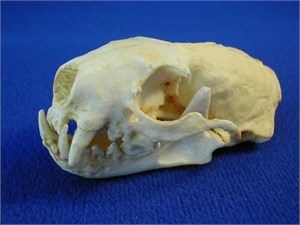Prairie Dog Hunter Skull Replica measures 2.7 inches. Prairie Dog Hunter Skull is museum quality Polyurethane cast. Made in USA. Cast is from original California Academy of Sciences specimen. 2-part skull (separate cranium and jaw). Known as Black Footed Ferret. Our precise skull can be used as a teaching tool, museum skull exhibit, home decor skull, or office decor skull.
The Prairie Dog Hunter has a long, slender body with black outlines such as the feet, ears, parts of the face and its tail. The forehead is arched and broad, and the muzzle is short.
It has few whiskers, and its ears are triangular, short, erect and broad at the base. The neck is long and the legs short and stout.
The toes are armed with sharp, very slightly arched claws. The feet on both surfaces are covered in hair, even to the soles, concealing the claws.
The Prairie Dog Hunter skull resembles that of polecats in its size, massiveness and the development of its ridges and depressions, though it is distinguished by the extreme degree of constriction behind the orbits where the width of the cranium is much less than that of the muzzle.
The Prairie Dog Hunter attenuate body, long neck, very short legs, slim tail, large orbicular ears and close-set pelage is much closer in conformation to weasels.
Males measure 19.7 to 21.0 in. in body length and 4.5 to 5.0 in. in tail length. Females weighs 1.43 to 3.09 lb.
The Prairie Dog Hunter base color is pale yellowish or buffy above and below. The top of the head and sometimes the neck is clouded by dark-tipped hairs.
The face is crossed by a broad band of sooty black, which includes the eyes. The feet, lower parts of the legs, the tip of the tail and the preputial region are sooty-black.
The Mustela nigripes area midway between the front and back legs is marked by a large patch of dark umber-brown, which fades into the buffy surrounding parts.
A small spot occurs over each eye, with a narrow band behind the black mask. The sides of the head and the ears are dirty-white in color.
The dentition of the Black-footed Ferret closely resembles that of the European and steppe polecat, though the back lower molar is vestigial, with a hemispherical crown which is too small and weak to develop the little cusps which are more apparent in polecats.
The Prairie Dog Hunter is solitary, except when breeding or raising litters. It is nocturnal and primarily hunts for sleeping prairie dogs in their burrows. It is most active above ground from dusk to midnight and 4 am to mid-morning.
Aboveground activity is greatest during late summer and early autumn when juveniles become independent. Climate generally does not limit M. nigripes activity, but it may remain inactive inside burrows for up to 6 days at a time during winter.
In captivity, gestation of Black-footed Ferrets lasts 42–45 days. Litter size ranges from one to five kits. Kits are born in May and June in prairie dog burrows.
Kits are altricial and are raised by their mother for several months after birth. Kits first emerge above ground in July, at 6 weeks old.
They are then separated into individual prairie dog burrows around their mother’s burrow. Kits reach adult weight and become independent several months following birth, from late August to October.
Based on 86 Prairie Dog Hunter scats found near Meeteetse, Wyoming, 87% of their diet was composed of white-tailed prairie dogs.
Other food items included deer mice, sagebrush voles, meadow voles, mountain cottontails, and white-tailed jackrabbits. Water is obtained through consumption of prey.

